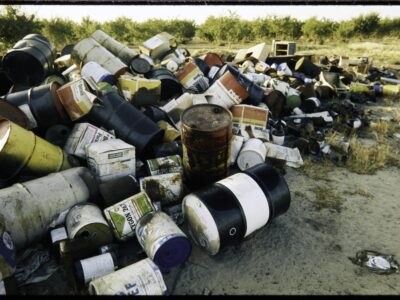A new look for fuel economy stickers
 If you go shopping for a new car in model year 2013, you’ll see a new sort of fuel economy window sticker, like the one to the left.
If you go shopping for a new car in model year 2013, you’ll see a new sort of fuel economy window sticker, like the one to the left.
This is a fascinating example of the challenges of making labels both easy to absorb and informative. (It’s definitely going in my environmental law casebook update.) It’s far more informative than the previous version, effective with model year 2008, shown below. (And that one already had more information than the ones I encountered last time I was in a showroom, many years before that.)
(And that one already had more information than the ones I encountered last time I was in a showroom, many years before that.)
The new label tells you how many gallons you’ll burn to go 100 miles rather than just how many miles you’ll get per gallon, a number which can be misleading in comparisons (see this explanation). It provides not only an estimated annual fuel cost, which may be the most relevant number for most consumers, but also a comparison with the fuel cost of an “average” mileage vehicle. It offers sliding scale ratings for fuel economy/GHG emissions and smog. And, for today’s techno-savvy consumers, it includes a pointer to the fueleconomy.gov website for more information, and even a smartphone-readable code.
But will consumers find the forest in all these trees?
Some of the complexity is attributable to changes in the marketplace. In 1977, when the first generation of labels was mandated, there were just conventional gasoline internal combustion cars. Now there are all kinds of fuels and technologies. The agencies have worked hard to try to come up with metrics for comparing fuel economy and environmental performance across the range of current and foreseeable technologies. Some of the complexity is attributable to Congress, which has mandated that the labels contain quite a lot of information.
The final rule rejected a visually simpler version dominated by a single large letter grade.  The National Automobile Dealers Association and Alliance of Automobile Dealer Manufacturers opposed the letter grade labels, while most environmental and consumer groups supported them. In the final rule, EPA chose two separate sliding scale ratings instead of a single letter grade because
The National Automobile Dealers Association and Alliance of Automobile Dealer Manufacturers opposed the letter grade labels, while most environmental and consumer groups supported them. In the final rule, EPA chose two separate sliding scale ratings instead of a single letter grade because
While a letter grade rating can be readily understood, the agencies agree with some commenters‘ concerns that it may imply more meaning about overall vehicle attributes—such as an assessment of overall quality on a number of factors–than was intended. We recognize that the letter grade is a fairly significant departure from the current fuel economy label, which provides absolute numerical values and no relative ratings.
What do you think? Did EPA make the right choice?
(If you’re a complete geek, you can read the entire Federal Register explanation for the new labels.)
Reader Comments
3 Replies to “A new look for fuel economy stickers”
Comments are closed.







I would have preferred a letter grade, but the fact the new labels will compare across vehicle classes is a major improvement, as is the emphasis on cost. It’s true there’s likely too many numbers crammed onto the label, but I think the “You will save” or, maybe even more importantly, the “You will spend $XXX more than you would relative to the average car,” language should move folks in the right direction.
I like the new stickers. Lots of good information. Declare victory and move on to the next fight.
Interestingly, appliance labels made a similar switch way back in 2007, emphasizing estimated annual operating costs while retaining information about energy consumption and efficiency. This seems like a good step for the fuel economy stickers.
I also would have preferred a letter grade, or, better yet, a graphic label like FDA’s proposal for cigarettes: http://www.fda.gov/TobaccoProducts/Labeling/CigaretteProductWarningLabels/default.htm. I’m concerned that the new design is too busy, especially with the somewhat erratic use of boldface type, but I’ve never gone shopping for a new car.
As an official complete geek, I’d be remiss if I don’t praise the agencies’ decision to compare vehicles across all classes rather than just to similar models. Had they listened to industry and not done that, the stickers could have misled customers into thinking that cars with inherently inefficient designs (like SUVs) were efficient, so long as they were more efficient than other models with the same type of design. This is the same approach that results in refrigerators with top-mounted freezers qualifying for Energy Star, even though they’re less efficient than non-Energy Star refrigerators with bottom-mounted freezers, or, smaller units with similar designs.
The problem is the way the agencies justify this, relying on research showing that many consumers initially consider cars in multiple classes when they go shopping. This is a problem because that kind of research may not exist for every other product that’s supposed to be labeled under the statutes. It’s also the tail wagging the dog: the labeling programs under EPCA and EISA were designed to influence consumer behavior, not just inform it.